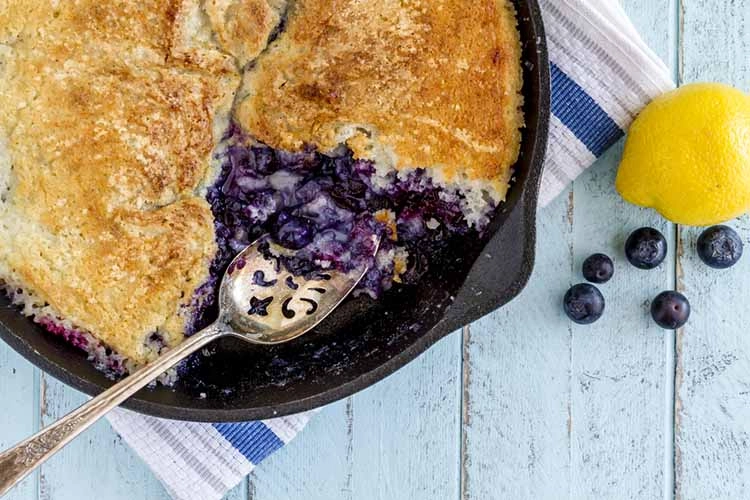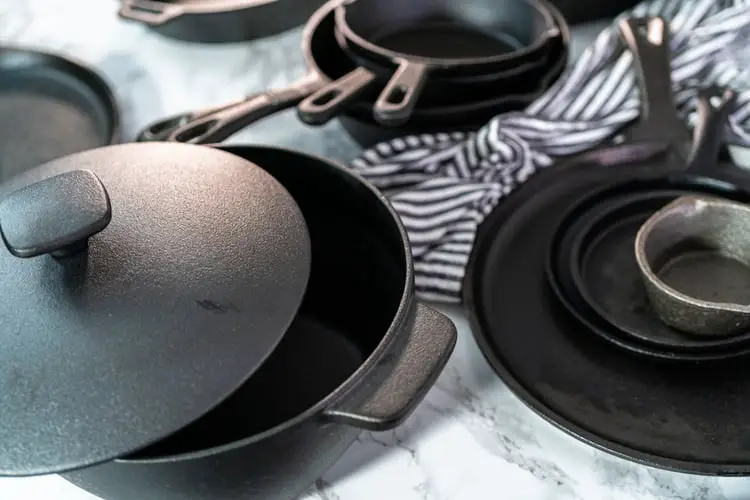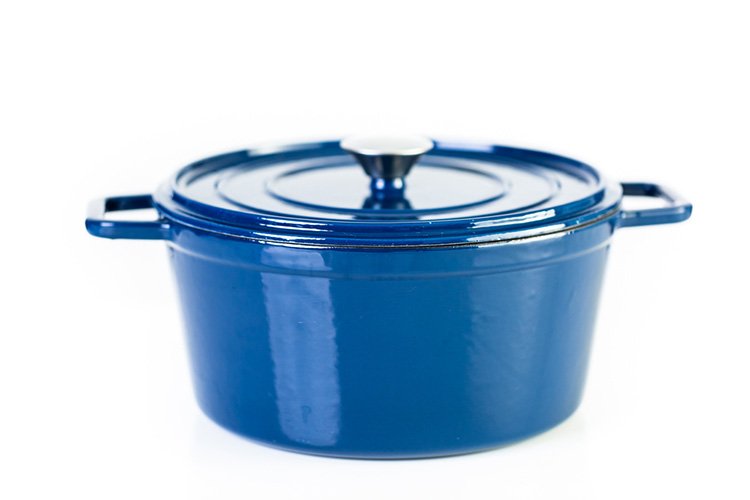Cast Iron Cookware Versus Dutch Oven: What’s the Difference?
If you are wondering what the difference is between a cast iron pan and a Dutch oven, you’ve come to the right place.
We’re going to cover the differences between a cast iron pan and a Dutch oven, including the materials typically used to make them. Dutch ovens typically use enameled cast iron, while regular cast iron is a popular choice for skillets and frying pans. We’ll explain why shortly. Dutch ovens also typically come in rather specific forms.
We’ll also talk about the common uses for each and when a Dutch oven may perform better or vice-versa.
About Dutch Ovens
A Dutch oven typically looks like a large pot or kettle. Often, the pot is quite deep, making the Dutch oven a wise choice for cooking stews and sauces. If you’re making chili or want to cook braised beef, the Dutch oven is a great choice.
Typically, a Dutch oven comes with a tight-fitting lid. When used properly, you can trap steam and heat inside the pot. This makes Dutch ovens great for moist cooking and slow cooking.
Modern Dutch ovens typically use enameled cast iron, which offers some benefits and drawbacks compared to regular cast iron.

About Cast Iron
Cast iron pans and cooking equipment comes in many different shapes and sizes. When many people hear the term “cast iron pan,” however, they’re often thinking of a cast-iron frying pan or skillet.
Cast iron frying pans have become quite popular in recent years. Cast iron allows for even heating, and if properly seasoned, its non-stick properties can come in handy both while cooking and cleaning up afterward.
A cast-iron pan is often deeper than Teflon or ceramic frying pans. Many (but not all) cast iron pans can be used as bakeware in the oven as well. This makes them great options for baking recipes like muffins and bisquits. Often, Teflon and ceramic frying pans can’t be used inside the oven.
Besides frying pans, however, you can also find cast iron pots, cast-iron casserole pans, and other things. You can even find regular cast iron cookware that closely resembles a Dutch oven.
That said, Let’s take a look at the differences between traditional cast iron and enameled cast iron.
Key Differences Between Cast Iron and Enameled Cast Iron
Cast iron has been used in cooking since at least 2,500 B.C. Cast iron offers excellent heating properties, and when properly seasoned has non-stick properties as well. It’s no surprise then that cast iron has remained a popular choice for cookware through the centuries.
Dutch ovens often use enameled cast iron, which features a thin porcelain enamel. Enameled cast iron first started to appear in the mid 18th century. These early enameled iron pans were quite primitive, and many people worried about poisoning. In 1799, Dr. Samuel Hickling in Birmingham patented a way to coat iron with enamel.
Still, enameled cast iron didn’t become popular until the late 19th and early 20th centuries. Over time, manufacturing processes improved, and costs came down, making enameled cast iron more affordable for middle and working-class families.
So why is cookware using these materials so popular? Let’s take a look at the pros and cons of cast iron and enameled cast iron.
Cast Iron vs Enameled Cast Iron: Pros and Cons
Both enameled cast iron and regular cast iron deserve a place in your kitchen. Here are some pros and cons to each.
Enamelware – pros
- Enamelware is great for cooking because it’s often non-stick and typically won’t interact with your food.
- Enameled cast iron typically performs much better with slow cooking and recipes that involve acidic ingredients, such as citric juices.
- The enamel is less likely to break down or interact with your food. Given that Dutch ovens are often used for slow cooking and moist cooking, enameled cast iron Dutch ovens have become quite popular.
Enamelware – cons
- Enameled cast iron isn’t as thermally conductive as regular cast iron, which can slow down cooking and may result in some uneven heating at times.
- If you drop an enameled cast iron pan, the enamel could crack.
- Enameled cast iron is often more expensive.
Cast Iron – pros
- A properly seasoned cast iron pan will have a layer of fats and oils that provides non-stick properties.
- Cast iron is more durable – it can last forever if properly maintained. Metal spatulas, for example, typically won’t harm a cast iron pan but could chip or otherwise damage the enamel coating on enamel-coated cookware.
Cast Iron – cons
- Regular cast iron, especially if not properly seasoned, can cause your food to have a metallic taste. Your food may even become discolored.
- Cast iron pans also shouldn’t be used for slow cooking. If you’re going to slow cook a tomato sauce for several hours, the seasoning may not hold up. Your food’s flavor could be impacted and may taste metallic.
- Not recommended for acidic foods, such as fish with a citric sauce, in a cast iron pan. The acidity could break down the seasoning. Your food’s flavor may suffer as a result.
- You can damage the seasoning layer on your cast iron pan while cooking or cleaning. That said, re-seasoning your pan is pretty easy.
- Rust can be a problem with cast iron, but an enamel coating may prevent that.
Either way, with proper care, both enameled cast iron, and regular cast iron should last for years to come. Both cast iron and enameled cast iron can be used over an open flame while camping or if you’re spending time at your cabin. You may need a Dutch oven stand or cast iron cooking tripod, but you’ll find plenty of options. Just keep in mind, cast iron can quickly burn you if you’re not careful.
Take Away: Cast Iron and Enameled Dutch Oven Are Both Great
If you’re looking for sturdy cookware, both traditional cast-iron cookware and enameled cookware, including Dutch ovens, are great choices. With slow cooking, enameled cast iron is the better choice. Meanwhile, regular cast iron often performs better when you’re cooking something quickly.
Either way, when properly maintained and used, cast iron offers an excellent cooking experience with great heat conductivity and heating evenness. And if you’re camping or looking for cookware for your cabin, Dutch ovens and cast iron cookware often perform well over open flames and are quite durable.


